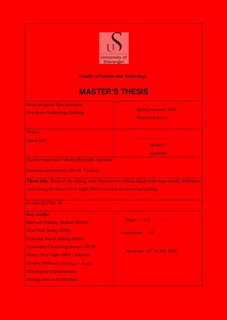| dc.contributor.author | Jafr, Goran | |
| dc.date.accessioned | 2018-10-23T14:57:46Z | |
| dc.date.available | 2018-10-23T14:57:46Z | |
| dc.date.issued | 2018-07 | |
| dc.identifier.uri | http://hdl.handle.net/11250/2569204 | |
| dc.description | Master's thesis in Petroleum engineering | nb_NO |
| dc.description.abstract | Abstract
This study is based on the use of an innovative drilling technology, called Reelwell Drilling Method (RDM), recently developed and tested to solve various issues related to conventional drilling methods. These include extended reach horizontal drilling (ERD) limitations, control of downhole pressure, hole cleaning and overcoming challenges related to equivalent circulation density (ECD). The RDM can be used to utilize a unique fluid configuration called heavy over light (HOL) solution. The HOL solution allows a heavy fluid in well annulus to control well pressure, while an active light fluid circulates through a dual channel drill string and transports cutting up to the surface. Such combination provides increasing buoyancy of the drillstring and hence reducing torque and drag, which in turn leads to overcoming ERD-limitations. Other advantages are increasing weight on bit (WOB), better hole cleaning in horizontal section, and managing downhole pressure and ECD issues.
A challenge with the RDM-technology is the control of the mixing zone between the fluids in the HOL-configuration. During this thesis, a series of experiments were performed using water-based muds with different densities and rheological properties. The purpose of the experiments was to study the effect of these properties as well as the impact of the rotation speed (rpm) of the drillstring on the mixing zone between the fluids. A simple small-scale experimental rig was built, where an aluminum rod, representing the drill string, was rotated in an acrylic cylinder, representing the wellbore. The light fluid was placed in the lower part of the acrylic cylinder with the heavy fluid on the top. Two different color indicators, green for the light and red for the heavy fluid, were used. Photos of the mixing zone were taken at an interval of 30 sec. The height of the mixing zone was determined by analyzing the photos visually, and by an image analysis tools in MATLAB.
The results from the experiments indicated that rotation of the rod was important to avoid channeling effects. However, high rpm did not have a significant effect on the further development of the mixing zone. The rheological properties such as yield point and gel strength were found to be determining factors of controlling the stability of the mixing zone.
The results have shown that the HOL-arrangement with a density difference of about 0.70 sg between the fluids was controllable. Further investigations with larger well dimensions are still needed to be representative for field use of the results. | nb_NO |
| dc.language.iso | eng | nb_NO |
| dc.publisher | University of Stavanger, Norway | nb_NO |
| dc.relation.ispartofseries | Masteroppgave/UIS-TN-IEP/2018; | |
| dc.rights | Attribution-NonCommercial-NoDerivatives 4.0 Internasjonal | * |
| dc.rights.uri | http://creativecommons.org/licenses/by-nc-nd/4.0/deed.no | * |
| dc.subject | petroleumsteknologi | nb_NO |
| dc.subject | boreteknologi | nb_NO |
| dc.subject | reelwell drilling method | nb_NO |
| dc.subject | dual drill string | nb_NO |
| dc.subject | extended reach drilling | nb_NO |
| dc.subject | equivalent circulating density | nb_NO |
| dc.subject | heavy over light-solution | nb_NO |
| dc.subject | density difference | nb_NO |
| dc.subject | rheological characteristics | nb_NO |
| dc.subject | mixing zone at the interface | nb_NO |
| dc.subject | rotational action force | nb_NO |
| dc.title | Study of the mixing zone between two drilling fluids with large density difference, when using the Heavy Over Light (HOL) solution for terrestrial drilling. | nb_NO |
| dc.type | Master thesis | nb_NO |
| dc.subject.nsi | VDP::Teknologi: 500::Berg‑ og petroleumsfag: 510::Petroleumsteknologi: 512 | nb_NO |

